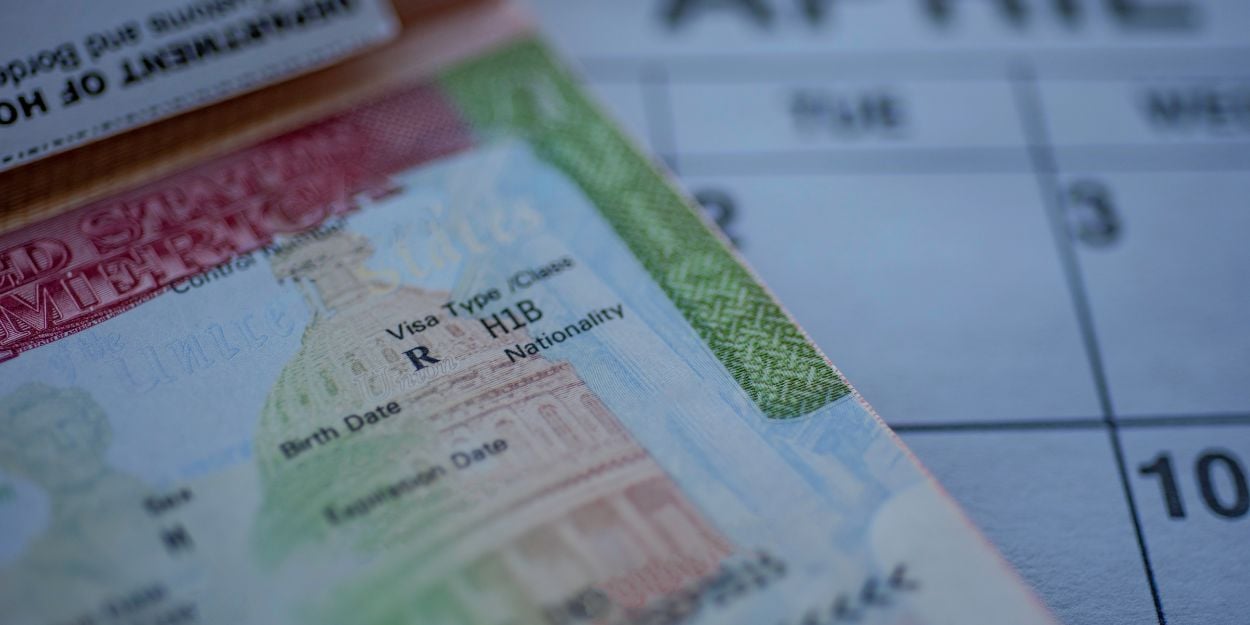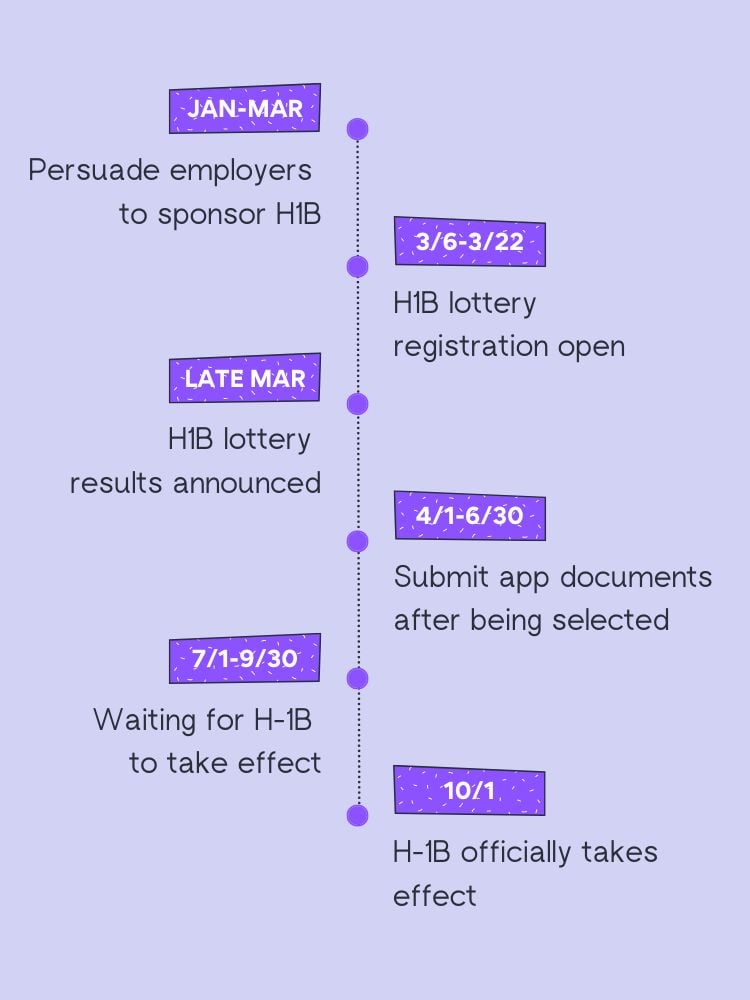FY 2026 H-1B Visa Comprehensive Guide
H-1B Lottery, H-1B Application, H1B Extension, and H-1B Unemployment
In this Guide
For international employees eyeing opportunities in the United States, the H-1B visa represents a critical pathway to professional development and career growth. As we step into FY 2025, it's pivotal to grasp the intricacies of the H-1B visa process, tailored to meet unique needs and challenges. This guide aims to demystify the process, spotlighting eligibility, application steps, and key changes, ensuring everyone is well-prepared to navigate the evolving landscape of U.S. immigration policies.
H-1B Status & H-1B Visa
The H-1B program serves as a non-immigrant classification that enables U.S. employers to temporarily hire foreign workers in specialized occupations. These positions typically require specialized knowledge and at least a bachelor's degree in the specific field or its equivalent. To address the high demand for H1B visas, USCIS (U.S. Citizenship and Immigration Services) employs a random selection process, known as the H1B lottery, to select applicants who meet the annual quota cap.
H-1B is typically divided into two types: Cap-subject H-1B and Cap-exempt H1B. The Cap-exempt H-1B is usually sponsored by non-profit organizations associated with higher education institutions and does not require participation in a lottery. On the other hand, cap-subject H-1B visas are limited in number, with an H-1B Regular Quota of 65,000 visas and an H-1B Master’s Quota of 20,000 visas. This article primarily discusses the Cap-subject H-1B.

The H-1B visa is a document placed in your passport allowing entry into the U.S. for a specific purpose and duration. Conversely, H-1B status refers to your legal status within the U.S., governed by the terms under which you were admitted, such as your employment eligibility.
As a current international employee already in the United States, when your employer submits an H1B application on your behalf and it is approved, you will typically automatically obtain H-1B work status in October of the same year. You only need to apply for an H1B visa when you need to leave and re-enter the United States.
Who is eligible for H-1B:
H-1B status is available to individuals who have been offered a temporary professional position by a U.S. employer. To qualify for H-1B status, the position must require at least a bachelor's degree or higher in a related field, and the H-1B employee must possess this degree (or higher).
How to Participate in H-1B Lottery and Apply for H-1B
To participate in the H-1B lottery and apply for H-1B, applicants must first secure a job offer from a U.S. employer willing to sponsor their H-1B visa. The employer then registers the candidate in the H-1B lottery system during the designated registration period, typically March of the year. If selected in the lottery, the employer can proceed to file an H-1B petition on behalf of the candidate. It's essential for candidates to ensure their qualifications match the specialty occupation requirements and to prepare all necessary documentation in advance to facilitate a smooth application process.

Changes in Registration and Selection Process for FY 2025
USCIS has made significant changes to the H-1B program to prevent fraud and ensure fairness. They are implementing steps to discourage multiple registrations for the same individual and will now select registrations by unique beneficiaries. USCIS is also updating the H-1B registration accounts, increasing fees, and introducing online filing options. The new organizational accounts will allow collaboration and preparation of H-1B registrations. The filing fees for I-129 H-1B petitions and premium processing will increase from April 1, 2024.
I-129 filing fee: $460
I-907 premium processing fee: $2,500
I-129 filing fee: $780
I-907 premium processing fee: $2,805
H-1B Fee and Relative Cost
The total cost for the H-1B application starts at $2,540.
Below is the breakdown of the fee type, fee amount in USD, and details of the fee.
H-1B Unemployment
H-1B status holders face strict rules regarding unemployment. The regulations allow a grace period, typically up to 60 days or until the end of their authorization period, whichever is shorter, for H-1B workers to find new employment or change their visa status if they lose their job. This grace period is crucial for maintaining legal status in the U.S. without immediately having to leave the country upon job loss. It's important for H-1B visa holders to plan accordingly and understand their options during this period.
A person can use the 60-day grace period multiple times, but each time it must be under the same H1B. Each authorization grants a 60-day grace period. During each authorization period, the grace period can only be used once."An individual may benefit from the 60-day grace period multiple times during his or her total time in the United States; however, this grace period may only apply one time per authorized nonimmigrant validity period."For instance, if you were laid off by Company A and used the grace period to find Company B, which then carries out an H1B Transfer (this is the same H1B, not a new H1B), and unfortunately, you were laid off by Company B as well, then you no longer have the 60-day grace period available. At this point, you need to consider urgently changing your status before the termination date proposed by the company, such as enrolling in a school urgently to switch to an F1 visa or something similar.
No, you cannot work during the 60-day grace period. This grace period is designed to allow individuals on H1B visas time to seek new employment and apply for a change of status or arrange for departure from the United States. It is not a period during which you are authorized to work.
While it is everyone's hope to receive a new job offer during the H-1B grace period, it is important to acknowledge that finding a new job is not guaranteed. Therefore, it is advisable to have backup plans in place in case you are unable to secure employment within this period. Even if you are unable to find a job during this time, there are alternative options you can consider to continue working. Here are a few commonly recommended strategies:
(1) Switch to a Visitor Visa B1/B2
This is a visitor visa but also a short-term transitional visa. You can wait until you find a suitable job and then switch back to H-1B. However, please note that there is a limit of 6 months for the duration of stay after switching to B status.
(2) Switch to H4 or another partner visa (if applicable)
This is a dependent visa for family members of those holding an H1B visa, but H4 itself does not allow for work unless you have an EAD card. However, to apply for a work permit, the H1B partner must have submitted the I-140 and it must have been approved by USCIS.
(3) Switch to an F1 visa
Enroll in a better graduate program or attend a Day 1 CPT university (where the academic pressure is manageable, and you can later work full-time/part-time directly under CPT). Once you find a new job that supports H-1B, you can switch back to H-1B status at any time. For specific considerations when looking for Day 1 CPT universities, you can check here.
H-1B Extension
An H-1B extension allows visa holders to continue working in the U.S. beyond their initial 3-year authorization, up to a maximum of 6 years. Applicants must have their employer file a petition for an extension before their current H-1B status expires. It's crucial for both the employer and the employee to start the extension process well in advance to ensure continuous employment eligibility.
The application process and preparation of materials for an H-1B Extension are similar to those for the initial H-1B application, except that a lottery is not required for extensions. Employers need to reapply to the Department of Labor for an LCA, prepare the Form I-129, pay the application fees, and include the I-797 approval notice from the initial H-1B application, recent three months' payslips to prove that the beneficiary has been continuously working for the employer, along with other standard documents like the passport, I-94 record, and educational certificates.
An H-1B extension allows visa holders to continue working in the U.S. beyond their initial 3-year authorization, up to a maximum of 6 years. Applicants must have their employer file a petition for an extension before their current H-1B status expires. It's crucial for both the employer and the employee to start the extension process well in advance to ensure continuous employment eligibility.
The application process and preparation of materials for an H-1B Extension are similar to those for the initial H-1B application, except that a lottery is not required for extensions. Employers need to reapply to the Department of Labor for an LCA, prepare the Form I-129, pay the application fees, and include the I-797 approval notice from the initial H-1B application, recent three months' payslips to prove that the beneficiary has been continuously working for the employer, along with other standard documents like the passport, I-94 record, and educational certificates.
Concurrent H-1B
Concurrent H-1B status allows an H-1B visa holder to be employed by more than one employer simultaneously. For this to happen, a new employer must file an H-1B petition on behalf of the visa holder, indicating it's a concurrent filing. This process enables H-1B workers to undertake additional employment while maintaining their primary H-1B status, provided all employers meet the necessary H-1B program requirements. This flexibility benefits visa holders seeking diverse professional experiences or additional income.
From a legal perspective, there's no explicit prohibition on holding two full-time positions, but the application process tends to be more challenging, and the USCIS approval rate is very low. This is because USCIS considers it unreasonable for a person to work 70+ hours a week.
The application process for a Concurrent H1B is the same as for a regular H1B. The employer must pay the same application fees and provide the same proof. The only difference is that, when filling out the H1B category, the lawyer will select Concurrent H1B and specify your weekly working hours.
Your primary H1B employer will not be aware of the concurrent H1B processing. Whether to inform them is your decision to make. Not all employers are concerned about this; if you have a good relationship, your employer might even support this decision.
What if not selected in H1B Lottery
For international employees not selected in the H-1B lottery, there are several alternatives to consider. These include applying for Optional Practical Training (OPT) extension if eligible, enrolling in further studies to maintain student status (such as enrolling in a Day 1 CPT university), or seeking other visa categories such as O-1 for individuals with extraordinary abilities, L-1 for intra-company transfers, or even the TN visa for Canadians and Mexicans. Each option has its own set of requirements and benefits, offering various pathways to continue living and working in the U.S.
O1 Visa: Individuals with Extraordinary Ability or Achievement
Difficulty: Relatively high, as applicants must meet strict criteria, such as awards, published work, significant contributions to their field, etc.
Long-term Stay: Yes, the initial period of stay is three years, extendable annually with no upper limit.
Work Authorization: Yes, but limited to the specific employer and position approved in the O1 visa application.
L1 Visa: Intracompany Transferee
Difficulty: Moderate. It requires demonstrating the necessity of the transferee to the U.S. and the qualifications of the applicant.
Long-term Stay: Yes, up to 7 years for L1A (managers or executives) and 5 years for L1B (specialized knowledge employees), with potential pathways to a green card.
Work Authorization: Yes, but only for the specific company and position mentioned in the application.
Day 1 CPT
Difficulty: Lower, available for most international students.
Long-term Stay: The duration of programs varies, with most master's programs lasting between 1 and 2.5 years, and most doctorate programs lasting between 3 and 5 years.
Work Authorization: Yes, but the work must be closely related to the field of study as part of the curriculum.
Dependent Visa (e.g., H4, L2 Visas)
Difficulty: Lower, dependent on the primary visa holder's status.
Long-term Stay: Possible, but contingent on the primary visa holder's status.
Work Authorization: H4 visa holders may apply for work authorization under certain conditions, and L2 visa spouses can also apply for work authorization.
❗️Navigating the complexities of the H-1B is a crucial step for international employees aiming to establish professional careers in the U.S. This guide has outlined essential aspects from application to potential alternatives, emphasizing the importance of preparation and understanding of the process. As immigration policies evolve, staying informed and exploring all available options will be key to achieving your career objectives in the United States.
If you aren't selected in the H1B Lottery, considering Day 1 CPT as an alternative can be a beneficial choice.
Contributors:

Anthony Grower
Topic Specialist

Kelly Brighton
Topic Specialist

Richard Peace
Topic Specialist
Sources:
Note: All the information above is time-sensitive. We recommend contacting professional lawyers before making any decisions. None of the information in this article is intended to provide legal advice.
Full Day 1 CPT Universities List
Click here to view 30+ Day 1 CPT universities in different states
Scholarships & Payment Plans
Click here to explore extensive scholarships and financial aid
Get Free Assistance Now
We can help you with admission, fee waiver, and scholarships



-3.jpg?width=1120&height=630&name=D1CU%20Blog%20Banner%20(1)-3.jpg)


.png?width=204&height=68&name=Verified%20(2).png)


.png?width=250&height=83&name=Logo%20-%20Rectangle%20(2).png)
.png?width=250&height=83&name=Logo%20-%20Rectangle%20(1).png)
